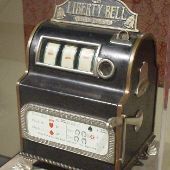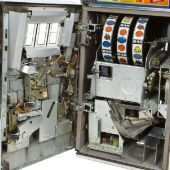A Complete Guide to Slot Machine History – One-Armed Bandits, Online Slots, and More

- The history of the slot machines began in 1876 with the world’s first proto-slot: The Guessing Bank.
- One-Armed Bandit machines were mechanical and reigned until video slots arrived in the 70s.
- Slots at online casinos make it easier for gamblers to win progressive jackpots.
Throughout the modern era of gambling, the slot machine has played many roles, from initial bit parts giving bar patrons a chance to win cigars or chewing gum to something for the wife to play.
At the same time, hubby rolled the bones and then to the huge elephant in the room responsible for the vast majority of casino profit.
That growth from seed to mighty oak took a very long time. Still, there’s a chain of innovation that brought slot machines from the simple mechanical novelties of the 1800s to awe-inspiring animations of today’s slots.
Some of which offer stupendous life-changing jackpots, most of which can be played on your phone.
Let’s breadcrumb our way along the one-armed bandit’s trek through history, from its first, barely recognizable countertop machines to the wildly imaginative online slot machines you find in cyberspace.
The Early Years (1876-1893)
We begin our history of slot machines journey with the early years.
You might be surprised to learn that the first slot machine was introduced to the world the same year General George Armstrong Custer and his troops met their fate at the Battle of the Little Bighorn.
It was in 1876 that the world’s first proto-slot machine started appearing on the countertops of bars and saloons.
There was a slot to accept a penny and a dial resembling a clock face which contained random numbers from 1 to 5.
Depositing a penny in the slot would cause the pointer to spin. The player was required to guess the number the pointer would land on when it stopped.
If there were any prizes, they were decided by the individual bars, and the machine was considered more of a novelty than a source of revenue.
Similar machines, including a rudimentary poker machine, were introduced in the next decade. Still, the machine did not pay the prizes and tended to be informal and varied from location to location.
Let Freedom Ring (1895)

It wasn’t until 1895 that a San Francisco mechanic named Charles Fey built the first device that would be recognizable as a slot machine even a century later.
Fey called this machine the Card Bell.
Soon renamed the Liberty Bell (after the symbol that gave the machine its highest paying pay line), Fey’s creation possessed all the attributes of a classic slot machine.
Those attributes include rotating reels, a pay line, a slot to accept coins, a “bucket” in which to collect winnings.
And let’s not forget the one attribute the Liberty Bell would share with all its progeny and imitators for the next eight or nine decades—the single lever that earned the machine its enduring nickname, One-Armed Bandit.
The Electrifying Years (1964-1973)

For the next 50 years, One-Armed Bandits were entirely mechanical, with little differentiation between the games.
The reason for this was simple: Slot machines weren’t what paid the bills for casinos—not back then, anyway.
The slots were dismissively considered “something to keep the wives busy” while the men huddled around the craps and roulette tables.
Consequently, no one spent much time trying to build a better slot machine. But that would change in 1964 when Bally Manufacturing Company introduced the electromechanical Money Honey.
This three-reeler operated electronically yet still retained the one-armed lever that needed to be pulled to trigger the reels to spin.
Video Slots Kill the One-Armed Bandit (1974-1978)
Despite some innovations and the addition of electromechanical works, slot machines still consisted of physical reels with various symbols on them.
That all changed when a small company called Fortune Coin hooked up a rudimentary computer to a 19-inch Sony television and created the world’s first video slot machine.
The slot was previewed to the gambling public inside the Las Vegas Hilton after a brief delay to work out the bugs in the programming.
Initially, gamblers were leery of playing video slots, but as the games available multiplied and became more familiar, video slots grew more popular.Soon video slots would all but replace electromechanical slots.
Incidentally, four years after introducing that first video slot, Fortune Coins was bought by IGT.
From an Afterthought to the Main Attraction (1996)
As I mentioned earlier, casinos didn’t treat slot machines like anything but what they were—a sideshow to the main attraction of the table games like blackjack, roulette, and craps.
Without this next innovation, the history of slots might have remained the tale of an also-ran or even a never-was.
In 1986, International Gaming Technology (IGT) introduced a game called Megabucks.
It was the first slot machine linked to others of its kind (via phone lines, of course). An early WAN (wide area network), if you please.
The play information on each Megabucks machine was transmitted to a central computer, which tallied the coins put into each by the slot players. A tiny percentage of each wager was added to a single jackpot, then displayed on a big lighted sign above the machines.
Initially seeded at $1 million, the Megabucks progressive would later be seeded at $10 million. Even with hundreds of competitors, Megabucks remains the BMOC of the slot world.
Online casinos offer a variety of local and networked progressive jackpots, some of which feature jackpots in the millions.
Not only that but there are hundreds of slots that offer hot drop progressive jackpots—smaller prizes but more frequently won.
Hot drops are immensely popular online because winning a thousand dollars from an hourly hot drop seems more realistic and doable than taking home that $33 million.
Be that as it may, progressives like Megabucks are largely responsible for slot machines leaving the shadows of the casino and taking center stage—mostly because casinos themselves saw that slots could be responsible for as much as 70% of their profits.
One particular online casino, Bovada, is known for its hot drop progressive jackpots. You can even try it for yourself below.
Multiple Screens Are Better than One (1996)
Some innovations aren’t as industry-changing as progressive jackpots or slicing the bread before you sell it, but they can still have an enduring effect on the industry.
Taking slots from the physical world to the electronic universe gave developers much greater freedom.
Until now, slot games had always been fairly simple, but the digital age opened entire worlds of gaming opportunities.
At first, the second screen was simply a different part of the game—usually a bonus feature—and presented on the same physical screen as the main game.
It wasn’t long, however, before actual additional screens were added. Eventually, this led to the large vertical screens on such modern-day classics as Aristocrat’s Buffalo.
The End of the Hopper Fill (1990-2005)

For a hundred years, slot machines delivered their winnings into metal buckets attached to their fronts, and every casino employed a team of people to administer these machines and keep them filled with coins.
Bill acceptors have been a part of the vending machine industry since the 1980s, but slot machines didn’t accept bills until the early 1990s. Acceptance was slow for several years, and casinos grappled with the expense of retrofitting slot machines (or replacing them).
The first slight change in slot machines was the introduction of the bill validator.
This allowed gamblers to insert a twenty-dollar bill (for example) into a slot machine, see the machine give them an equal amount of credits, and allow them to wager those credits as they would real money.
What was the difference, then?
Well, if you played slots before bill validators became commonplace, you know that you spent a good deal of your time cleaning the dirt and metal residue from quarters and the metal dollar tokens used by most casinos off your hands. Frequently.
Everybody had cleaner hands when we all moved into the 21st century. All that remained was a way to cash out without calling an attendant or tote plastic buckets of dollar tokens (or worse, quarters) over to the cashier station.
Ticket In-Ticket Out was an electromechanical method of validating cash and paper slips with printed bar codes.
This change took nearly a decade to sweep through the industry but is now used virtually everywhere.
Quite a bit of technology came into play to produce a useable and cheat-proof system whereby a player could cash out $1000 worth of winnings, take it to an ATM machine, and receive those thousand dollars in real money.
All without dealing with 20 pounds of tokens and/or standing in line at the swamped cashier’s cage.
Ask anybody you know who was an active slot player during that period. They will agree that the near-simultaneous introduction of bill validators and TITO was a watershed moment in the history of slot machines.
Hasta la vista, hoppers, and coin trays.
Minor Misstep or Simply Ahead of Its Time?
No slot machine in history would be complete without noting one of the more predictable failures in slot innovation.
In the 20-teens, game developers sought ways to entice younger generations—the so-called millennials, Gen X’ers, and Gen Z—to play the slots. One way was to introduce skill to the otherwise purely random play of the slot machine.
The intent was to inject enough skill into playing slots to bring the Play Station and Xbox generations to the casino floor while maintaining that random nature of slots to keep the older generations coming back for more.
It may be that combining skill with a game of pure chance changed the game so much that it must find its own audience and its own level of influence.
If the outcome of the game is random, then anyone can win. Or it may be that its honest randomness keeps people returning to the slot machine.
From an objective perspective, fairness is removed once the skill is added to a game.
Rise of Online Casino Slots

Virtually every successful innovation found in the history of the slot machine is present (in one form or another) in the world of online casino slots.
Cash is virtually invisible in cyberspace, which was—intentional or not—the object of introducing bill validators and, later, TITO.
The creativity encouraged by the vast realm of possibilities the video slot offers is even more obvious—and perhaps more daunting—in cyberspace.
By the way, if you’ve just discovered online casinos and are eager to get up to speed on all the basics, you’ll want to read our casino for beginners page for all the basic information and tips.
Back to cyberspace and online slots history.
Everything (not just money) in cyberspace is virtual, with the exchange of an enormous volume of ones and zeros representing anything from a deposit request to a flash of lightning animated on the screen of a video slot.
The Future of Slot Machines
For those of us already bitterly disappointed that we STILL don’t have personal jetpacks, the maturation of growth of the slot machine is encouraging.
But where do slots go from here? Online slots are already everything their predecessors promised.
The games offer not just the excitement of risk and reward but entertainment unrivaled by some dedicated video games.
Will we see the next generation of slot fans able to immerse themselves in a slot’s mini-universe? And perhaps once physicality has been fully introduced into the world of online slot machines, will there suddenly be a good reason for acquiring skill in an otherwise random game of chance?
Or will the next changes and improvements in the future history of slot machines be more subtle, like introducing five reels to a three-reel world, or the video slots that slowly but surely put the old mechanical one-armed bandits out to pasture?
One thing is certain: slot machines’ century-long history is swiftly becoming the history of online slots.
Let’s not forget, however, that slots, regardless of venue, are a simple pastime.
Like baseball’s description as a game where “you throw the ball, you hit the ball, you catch the ball,” the slot machine—whether it be an old campaigner like a Blazing Sevens three-reeler or an online slot that features multiple bonus games and 243 pay lines—is a simple machine to play.
You make your wager, spin the wheels, and reap your rewards. Glorious.
The history of slots has come a long way, but so have US casinos. In 2022, US casinos made a record $60 billion in GGR in 2022. If you want to know more about 2022 gambling statistics, check out the blog for more.
Footnotes:
- Global Gaming Business article explains the cash business side of the casino.
- Federal Reserve Bank of Richmond provides the coin and currency in the casino industry.
- History of Charles Fey and San Francisco’s Liberty Bell from the UC Press.
 75%
75% 80%
80%



